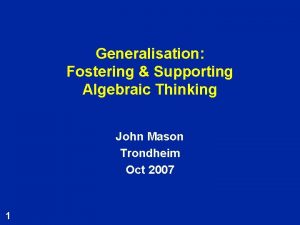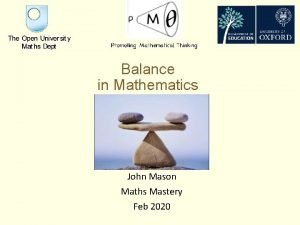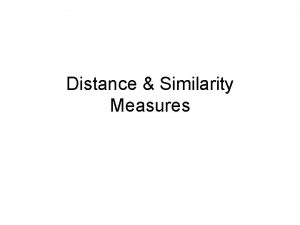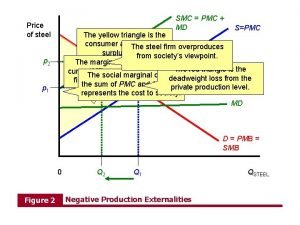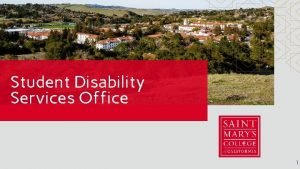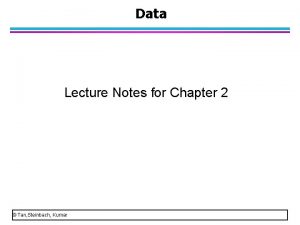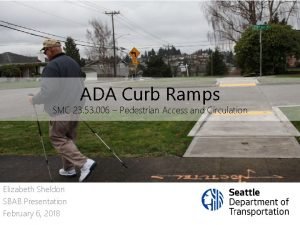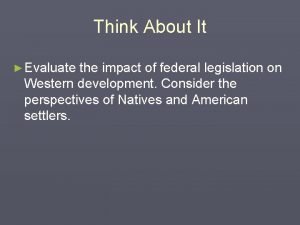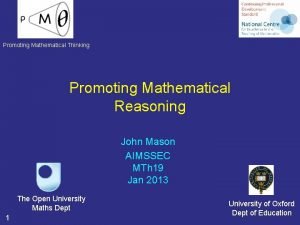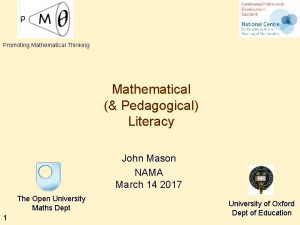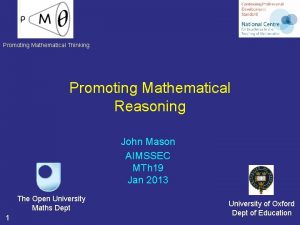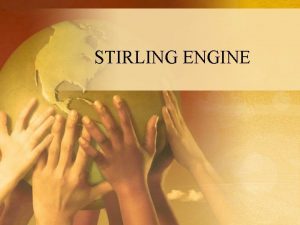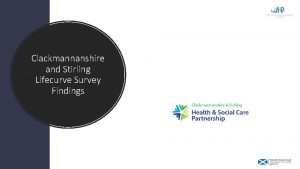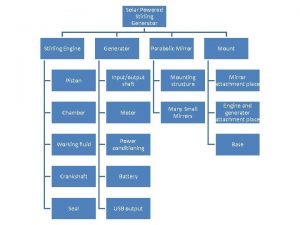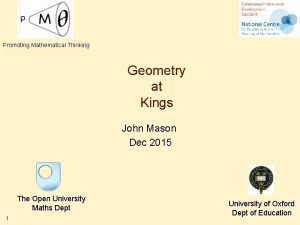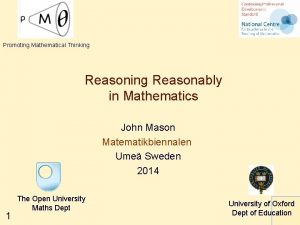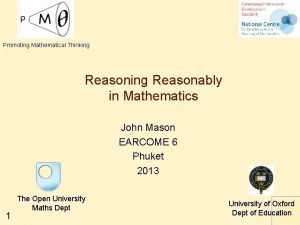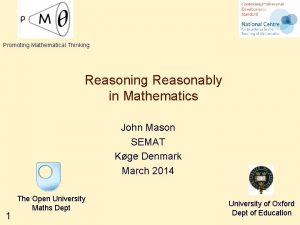Progress in Mathematical Thinking John Mason SMC Stirling




















- Slides: 20

Progress in Mathematical Thinking John Mason SMC Stirling Mar 6 2010 1

Outline /What is progress in mathematical thinking? /Progress in what? – Performance (behaviour) – Conceptual appreciation and understanding; connectedness; articulacy (cognition) – Independence & Initiative (affect) – Ways of working individually and collectively(milieu) /Need for a sufficiently precise vocabulary – to make thinking, discussion and negotiation possible Tasks that reveal progress 2

What is Progress? /Perceived change in – Behaviour (what people do) – Affect (what people feel about what they are doing; motivation; dispositions; initiative; confidence; selfefficacy etc. ) – Cognition (Awareness, Key developmental Understandings, Critical Features) – Meta: Learning how to learn mathematics /These come about as learners – Discern what can vary over what range, and what must remain invariant – Discern details, recognise relationships, perceive properties and reason on the basis of agreed properties – Make fundamental shifts in both what they attend to and how they attend mathematically 3

In Between /How many circles could there be between the two shown? Range of permissibl e change /How many numbers could there be between 1. 50 and 1. 59 1. 500 and 1. 5987 4 Discrete & Continuou s

Difference of 2 Primary 5 Secondary write down 2 numbers with a difference of 2 write down the equation of two lines with slopes differing by 2 Upper Secondary write down an integral over two different intervals whose values differ by 2 And another And another

Seeing As ✎ Raise your hand when you can see something that is 1/3 of something; again differently A ratio of 1 : 2 4/3 of something Threshold Concept: Clarifying the unit ✎ ✎ 6 What else can you ‘see as’? What assumptions are you making? Dimension s of possible variation Range of permissibl e change

7 Seeing through the particular to a generality

Regional /Arrange three coloured regions in order of area Generalise! 8 Dimensions-of-Possible. Variation

Doug French Fractional Parts 9

Making Mathematical Sense 10

Triangle Count 11

Reading a Diagram: Seeing As … x 3 + x(1–x) + (1 -x)3 x 2 z + x(1 -x) + (1 -x)2(1 -z) xyz + (1 -x)y + (1 -x)(1 -y)(1 -z) 12 x 2 + (1 -x)2 xz + (1 -x)(1 -z) yz + (1 -x)(1 -z)

Length-Angle Shifts /What 2 D shapes have the property that there is a straight line that cuts them into two pieces each mathematically similar to the original? 13

Tangential /At what point of y=ex does the tangent go through the origin? /What about y = e 2 x? /What about y = e 3 x? /What about y = eλx? /What about y = μf(λx)? 14

Progress in What? /Use – – – of their own powers To imagine & to express To specialise & to generalise To conjecture & to convince To stress & to ignore To persist and to let go /Enrichment of their accessible example spaces /Awareness of the pervasiveness of mathematical themes: – – – Doing & Undoing (inverses) Invariance in the midst of change Freedom & Constraint and of the opportunities to think mathematically outside of classrooms 15

Natural Powers /Imagining & Expressing /Specialising & Generalising /Conjecturing & Convincing /Organising & Characterising /Stressing & Ignoring /Distinguishing & Connecting /Assenting & Asserting 16

Conjectures /Progression can be seen in terms of /Dimensions-of-Possible-Variation & Range-of-Permissible-Change /Use of powers on own initiative – E. g. Specialising in order to re-Generalise /Construction tasks to reveal richness of accessible example spaces /Self-Constructed Tasks /Using Natural Powers to – Make sense of mathematics – Make mathematical sense 17

Mathematical Themes /Invariance in the midst of change /Doing & Undoing /Freedom & Constraint /Extending & Restricting Meaning 18

Reprise /What is progress and how is it revealed? – Use of powers – Initiative taken (assent-assert) – Disposition to enquire, to think mathematically outside of the classroom – Manifesting results of shifts in perspective v. Discrete & Continuous v. It just is – I was told it – It must be because 19

My Website & Further Reading /Mcs. open. ac. uk/jhm 3 go to Presentations /New Edition of Thinking Mathematically due in April 60 new problems related to the curriculum 20
 Copper plate multiplication
Copper plate multiplication Sybils group inc
Sybils group inc Physical progress and financial progress
Physical progress and financial progress Elements of mathematical economics
Elements of mathematical economics John mason maths
John mason maths Smc tool
Smc tool Santa monica college honors program
Santa monica college honors program Smc
Smc Andromeda smc
Andromeda smc Smc vs jaccard
Smc vs jaccard Smc technology sdn bhd
Smc technology sdn bhd Smc pmc
Smc pmc Spaq-co 12-59
Spaq-co 12-59 Smc ptk
Smc ptk Student disability services (sds) office
Student disability services (sds) office Smc ptk
Smc ptk Smc vs jaccard
Smc vs jaccard Mass effect info
Mass effect info Smc 23
Smc 23 John gast american progress
John gast american progress American progress john gast
American progress john gast
